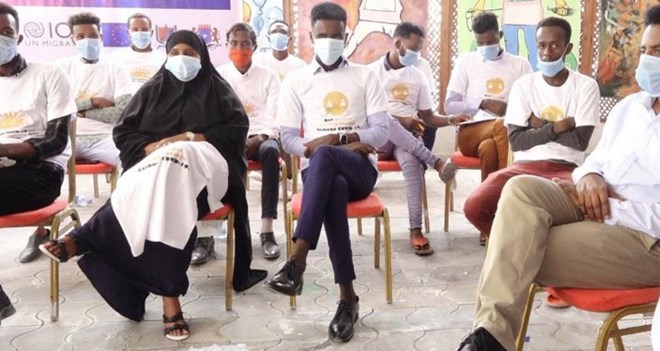IOM
Tuesday January 4, 2022

Somali nationals are active on all the three key migration routes out of the Horn of Africa: The ‘Eastern Route’ to the Arabian Peninsula, the ‘Northern Route’ to Libya and Europe, and the ‘Southern Route’ to South Africa.
But not all of those who set off on any one of these journeys make it. Some find themselves stranded in transit or even in the intended countries of destination. When this happens the migrants may wish to return to their communities of origin. To do this they often seek assistance from the EU-IOM Joint Initiative for Migrant Protection and Reintegration (the EU-IOM Joint Initiative).
The programme was launched a year after the 2015 Valletta Summit on migration, convened to address the urgent need to protect and save migrants’ lives, together with strengthening migration governance along the Central Mediterranean migration route. It was subsequently expanded geographically, and in scale.
However, the EU-IOM Joint Initiative retained its original focus of providing stranded migrants with the option to return to their communities of origin where they may also be provided with needs-based support to rebuild their lives.
The programme also supports all three Migration Response Centres (MRCs) in Somalia. In total, there are 12 MRCs located along the major migration routes in the Horn of Africa, which provide assistance to migrants in difficult and sometimes life-threatening situations.
The EU-IOM Joint Initiative marked its 5th anniversary on 16 December, and three events were held in Somalia to celebrate the occasion along with International Migrants Day, which is commemorated annually on 18 December.
The invitees were mainly returnees and members of the communities of origin.
In Mogadishu the venue was the MRC whose director, Mohiadin Abdullahi, emphasized the risks associated with irregular migration which he said had the potential to endanger the lives of migrants.
“We had a lovely conversation and not only were the risks of irregular migration discussed, but we were also able to talk about the skills that returnees can bring into their communities of return,” chipped in Hussein, a local youth.
Salaad Abdullahi, a returnee from Libya, said: “It was an important event in which returnees and youth discussed positive contributions to their communities and to the country at large, in addition to the skills and experience gained from overseas.”
In Bossaso, the local university hosted celebrations which brought students and returnees together for a discussion.
“I have never been able to sit and talk to young people who migrated and have now returned to the country, but today I had the opportunity to listen to their stories and discuss with them the issues that relate to me too," said Naasir Ali, one of the university students.
Abdikadir Awad, the Dean of Social Science at Bossaso University, added: “Migration through legal means and with a reason behind it is not a bad thing. The Prophet Muhammad emigrated from his hometown of Mecca in search of a better life to the city of Medina. So, young people should always know that.”
The main objective of the interactions in Bossaso was to raise awareness on irregular migration in general, and to highlight the services that IOM provides to migrants and returnees.
In Hargeisa the celebrations took on a different dimension, although the underlying the aim was also to raise awareness. The highlight was a film screening attended by representatives from the National Displacement and Refugee Agency (NDRA), returnees, members of host communities, UNHCR staff, and others from the Ethiopian Community Centre.
The film was about the ‘Eastern Migration Route’ to the Middle East and featured two Ethiopian migrants whose aim was to get to Saudi Arabia in search of a better life. But they did not make it and found themselves stranded in Somalia, albeit for different reasons.
“I never thought that migrants suffer that much during their journey. I hope my friends who had migrated before and now returned to their country, recovered from all those pains,” remarked Adam, a local youth.
Among those at the event was the head of IOM’s Somaliland sub-office, Ria Rashid. “December 18 is a special day to celebrate the role and contributions by migrants and returnees to host communities worldwide and on this important occasion, IOM advocates for safe, regular, and orderly migration and does not encourage irregular migration,” Rashid said.
The chairman of the NDRA, Abdikarim Hinif, paid tribute to IOM and the EU for their support to migrants and returnees. “Through the EU-IOM Joint Initiative, nearly 500 migrants were returned mainly from Libya to Somalia and hence we’re encouraging returnees to utilize the reintegration package provided by the programme to sustainably re-establish themselves in their communities.”